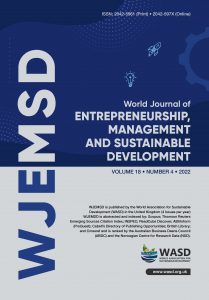Infrastructure quality and firm productivity in Africa, Edward Bbaale
 Edward Bbaale
Edward Bbaale
School of Economics
Makerere University, Kampala
Uganda
Email: eddybbaale@gmail.com
DOI: 10.1108/WJEMSD-11-2017-0091
Purpose: The World Bank (2017) ranks poor infrastructure, particularly electricity, as the second topmost obstacle (after access to finance) affecting enterprises in Sub-Saharan Africa. The purpose of this paper is to investigate the effect of infrastructure quality on firm productivity in Africa.
Design/methodology/approach: The author used the World Bank Enterprise Survey (WBES) for 26 African countries and employed both descriptive and ordinary least squares techniques during the analysis. The author circumvents the endogeneity of infrastructure in the productivity model by using firm-level measures of infrastructure quality rather than the stock of infrastructural capital.
Findings: On an average, 80 percent of manufacturing firms in Africa reported having experienced electricity outages in the financial year preceding the survey. Power outages are negatively associated with the productivity of small, medium, young, domestically owned firms and non-exporters. On the other hand, the author observes a substitution effect of generators for the unreliable power from the public grid and this effect positively influences the productivity of large, old, foreign-owned and exporting firms.
Practical implications: The author argues that in addition to infrastructure capital at an aggregate level, dealing with quality issues at firm level is required to enhance productivity. More attention needs to be put to the elimination of power outages so as to improve the productivity of all firms particularly those that cannot afford to use generators in the place of electricity from the public grid.
Originality/value: The author notes that there exists scanty empirical literature on the effect of infrastructure quality on productivity for the case of Africa despite the existence of WBES for at least two waves for both developed and developing countries. The uniqueness of this paper in comparison to the previous literature is that the author undertakes the analysis according to some important firm categories: size, age, ownership and export status. Additionally, the author uses the infrastructure quality to understand its effect on firm-level efficiency levels rather than the stock of infrastructural capital. The use of aggregate indicators of infrastructure introduces an endogeneity problem which the author circumvents in this study.
Keywords: Infrastructure; Quality; Productivity.
Citation: Bbaale, E. (2018), "Infrastructure quality and firm productivity in Africa", World Journal of Entrepreneurship, Management and Sustainable Development, Vol. 14 No. 4, pp. 367-384. https://doi.org/10.1108/WJEMSD-11-2017-0091

